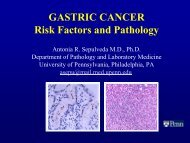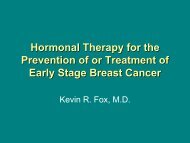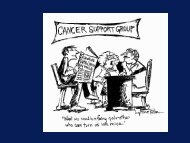Ovarian Cancer: Genetic Counseling and Testing, Screening and ...
Ovarian Cancer: Genetic Counseling and Testing, Screening and ...
Ovarian Cancer: Genetic Counseling and Testing, Screening and ...
Create successful ePaper yourself
Turn your PDF publications into a flip-book with our unique Google optimized e-Paper software.
<strong>Ovarian</strong> <strong>Cancer</strong>: <strong>Genetic</strong> <strong>Counseling</strong> <strong>and</strong><strong>Testing</strong>, <strong>Screening</strong> <strong>and</strong> PreventionJill Stopfer, MS, CGCCertified <strong>Genetic</strong> CounselorAbramson <strong>Cancer</strong> CenterUniversity of Pennsylvania
Familial Risk for <strong>Ovarian</strong>• Major risk <strong>and</strong> minor risk genes• Hereditary cancer risk• Sometimes source of cancer risk can be identified• Targeted management plan to lower risk <strong>and</strong>maximize chances for early detection
Family History of <strong>Ovarian</strong> <strong>Cancer</strong>• Average woman risk of ovarian cancer is 1-2% 1• One close relative with ovarian cancer• Mother, sister• Lifetime risk is 3-5% 3• Two close relatives with ovarian cancer• Lifetime risk is about 20%
Hereditary Risk for <strong>Ovarian</strong> <strong>Cancer</strong>• Single gene conferring significant risk• BRCA1 <strong>and</strong> BRCA2• Lynch Syndrome (MLH1,(MSH2, MSH6, PMS2)
BRCA1-Associated Associated <strong>Cancer</strong>s:Lifetime RiskBreast cancer 60%−80% (often early age at onset)Second primary breast cancer 40%−60%<strong>Ovarian</strong> cancer 30-45% Slightly increased risk ofUterine <strong>and</strong> Cervical cancerIncreased risk of other cancers:Colon: : 10-15%15%Male breast cancer: : 1-5% 1Pancreatic 2-3%
BRCA1-Linked HereditaryBreast <strong>and</strong> <strong>Ovarian</strong> <strong>Cancer</strong>92 Breast, dx 4586d. 8973 68 71Ovary, dx 59d. 62Breast,dx 3636Breast,dx 59NoncarrierBRCA1-mutationcarrierAffected withcancerASCO
BRCA2-Associated Associated <strong>Cancer</strong>s:Lifetime Riskbreast cancer(60%−80%)ovarian cancer(10%−20%)male breast cancer(5-10%)Other increased risks:Prostate: : 15-25%Pancreatic: : 3-5% 3Melanoma: : 3-5% 3
BRCA2-Linked Hereditary Breast <strong>Cancer</strong>Breast, dx 44d. 48d. 83Prostate, dx 64Breast, dx 3342Ovary, dx 65d. 6838 35UnaffectedMutation carrierAffected withcancer
Clinical Management ofBRCA Mutation-Positive PatientBreast <strong>Screening</strong> starting at age 25MammographyClinical Breast ExamsBreast Self ExamMRI screening<strong>Ovarian</strong> <strong>Screening</strong> starting at age 30CA-125Transvaginal ultrasoundEvery 12 monthsEvery 6 monthsEvery monthEvery 12 months(Alternate with mammos)Every 6-12 monthsEvery 6-12 months
Preventative SurgeryProphylactic Mastectomy•At least 90% risk reduction•Subcutaneous mastectomy not recommendedProphylactic Oophorectomy•Recommended after childbearing complete•With or without hysterectomy•HRT issues for young women•Shown to reduce BREAST cancer risk byat least 50% in pre-menopausal women•Reduces <strong>Ovarian</strong> cancer risk dramatically•Residual risk for primary peritoneal carcinoma
BR 51Stom 53 Brain 50Liver 72BR 29BR 58BR 35
BR 51OV 53 Brain 50OV 72BR 29BR 58BR 35
BR 51OV 53 Brain 50OV 72B1POSB1NEGB1POSBR 29B1NEGB1NEGB1NEGB1 POSBR 58B1POSB1NEGBR 35B1 POSB1NEGB1NEGB1POS
BR 51OV 53 Brain 50OV 72BR 29BR 58High riskFollow-upBR 35BR 39BSOHigh riskFollow-up
Risk Reduction from removing ovaries (oophorectomy) inwomen with BRCA1/2 MutationsStudy<strong>Ovarian</strong> CaBreast CaKauff 2002 85% 68%Rebbeck 2002 96% 53%Rutter 2003 71% *Eisen 2005 * 56%Domchek 2006 89% 64%Finch 2006 80% *Rebbeck 2009 80% 51%
Breast <strong>Cancer</strong> Risk Post-BPO in pre-menopausal womenwho use short term Hormone Replacement Therapy (HRT)HRT after oophorectomyBreast Ca Risk ReductionNone 62%Any 63%Estrogen Alone 56%Estrogen + Progesterone 57%Rebbeck et al, JCO 2005
Other Benefits of Prophylactic Oophorectomy inBRCA1/2 Mutation CarriersBreast <strong>Cancer</strong> Mortality<strong>Ovarian</strong> <strong>Cancer</strong> MortalityOverall Mortality90% reduction95% reduction76% reductionDomchek et al, Lancet Oncology 2006
Ignorance is not blissColon 68Prostate 60Colon 60Lung 70Ovary 51Ovary 30 Ovary 36Breast 40Breast 61 Renal cell 5540y 43y 46y 38y 31y
BRCA1 familyProstate 60Colon 60B1B1Lung 70B1Ovary 51Ovary 30 Ovary 36Breast 40Breast 61 Renal cell 55B1B140y 43y 46y 38y 31y
BRCA1 familyProstate 60Colon 60B1B1Lung 70B1Ovary 51Ovary 30 Ovary 36Breast 40Breast 61 Renal cell 55B1B140y BSO46y 38y 31yOvary 46BSOStage IV
Features That Indicate IncreasedLikelihood of Having BRCA Mutations• Multiple cases of early onset breast cancer• <strong>Ovarian</strong> cancer (with family history of breast orovarian cancer)• Breast <strong>and</strong> ovarian cancer in the same woman• Bilateral breast cancer• Ashkenazi Jewish heritage• Male breast cancer
Lynch Syndrome – also called HereditaryNon-Polyposis Colorectal <strong>Cancer</strong> (HNPCC)• Colon cancer risk – 80% risk• Extracolonic cancers:• Endometrium: : 40-60% risk• Ovary: 10% risk• Less than 10% risk: : stomach, urinary tract,small bowel, bile ducts, pancreas, sebaceousskin tumors
Amsterdam Criteria• 3 or more relatives with verified CRC in family• One case a first-degree relative of the other two• Two or more generations• One CRC by age 50• FAP excludedFailure to meet these criteriadoes not exclude HNPCCVasen HFA et al. Dis Colon Rect 34:424, 1991
The Family History Is Keyto Diagnosing HNPCCCRCdx 50sCRCdx 45CRCdx 61CRCdx 75<strong>Ovarian</strong>Ca, dx 64CRCdx 48CRCdx 52EndometrialCa, dx 5945CRCdx 42
<strong>Genetic</strong> <strong>Testing</strong> for<strong>Cancer</strong> SusceptibilityBegin genetic testing withaffected family memberPositiveresultNegativeresultOffer testing toat-risk familymembersContinued risk ofunidentified familialmutation
<strong>Genetic</strong> <strong>Testing</strong> for <strong>Cancer</strong> Risk in<strong>Cancer</strong>-free PatientsPositive resultTest at-risk individual,preferably from a familywith awith a known mutationNegative resultHigh-risk screening<strong>and</strong> interventionDefinitive negativeEmphasize continued riskof sporadic cancerGeneral populationscreening for cancer
<strong>Genetic</strong> <strong>Testing</strong> for <strong>Cancer</strong> Risk• Can establish what the source is for cancer risk inthe family• Can help individuals know more about risks foradditional cancer, <strong>and</strong> targeted screening• Can help family members by identifying thosewho are NOT at increased risk despite familyhistory
Psychological issues in <strong>Genetic</strong> <strong>Testing</strong>• Fear of the future, anxiety• Relief from uncertainty• Concern <strong>and</strong> worry for family members• Comfort in being able to provide helpful healthinformation to other family members• The issue of when to test, is as important aswhether to have testing
Concerns regarding discrimination• GINA – <strong>Genetic</strong> Information Non-DiscriminationAct of 2008• HIPAA protections of 1996


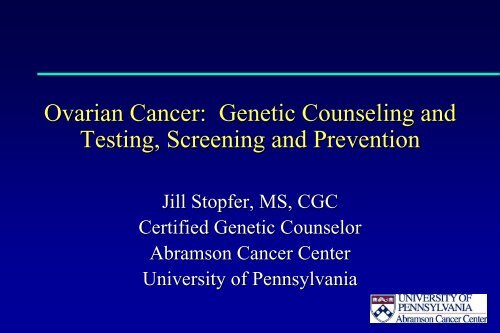

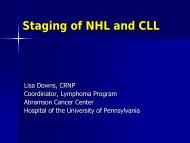
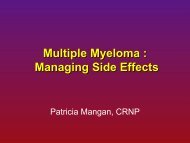
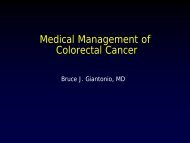
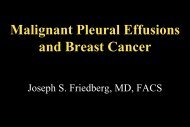

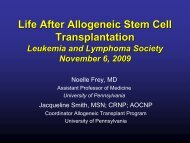
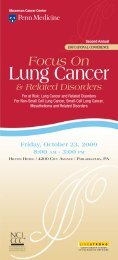

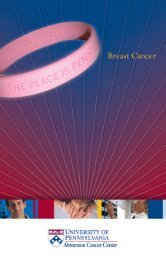
![Agenda [PDF] - Abramson Cancer Center](https://img.yumpu.com/35341208/1/190x245/agenda-pdf-abramson-cancer-center.jpg?quality=85)
